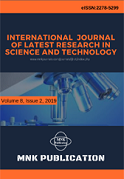DOI:10.29111/ijlrst ISRA Impact Factor:3.35, Peer-reviewed, Open-access Journal
Open Access
International Journal of Latest Research in Science and Technology Vol.11 Issue 1, pp 1-5,Year 2022
Correspondence should be addressed to :
Received : 25 January 2022; Accepted : 08 February 2022 ; Published : 10 March 2022

| Download | 0 |
|---|---|
| View | 7 |
| Article No. | 11028 |
This paper presents the modeling and simulation study of an electrochemical blood glucose sensor for clinical diagnosis. The working principle of the proposed sensing device is based on amperometry, that is, the measurement of electric current from a chemical reaction process. An applied voltage to the working and reference electrodes of the sensor resulted in the oxidation of glucose in the analyte sample, and the current due to this oxidation is measured at the electrode. As the input glucose concentration increases from 0.1M to 0.9M in the modeled glucose biosensor, the output response in terms of average current density increases linearly from 0.75 A/m2 to 7.8 A/m2. The linearity of response is a desirable property for an efficient measurement system.
Copyright © 2022 Babatunde S. Emmanuel et al. This is an open access article distributed under the Creative Commons Attribution 4.0 International (CC BY 4.0) license which permits unrestricted use, distribution, and reproduction in any medium, provided the original work is properly cited.
Babatunde S. Emmanuel, Stella A. Emmanuel , " Modeling And Simulation Study Of Electrochemical Sensor For Glucose Concentration Measurement In Clinical Diagnosis ", International Journal of Latest Research in Science and Technology . Vol. 11, Issue 1, pp 1-5 , 2022

MNK Publication was founded in 2012 to upholder revolutionary ideas that would advance the research and practice of business and management. Today, we comply with to advance fresh thinking in latest scientific fields where we think we can make a real difference and growth now also including medical and social care, education,management and engineering.

We offers several opportunities for partnership and tie-up with individual, corporate and organizational level. We are working on the open access platform. Editors, authors, readers, librarians and conference organizer can work together. We are giving open opportunities to all. Our team is always willing to work and collaborate to promote open access publication.

Our Journals provide one of the strongest International open access platform for research communities. Our conference proceeding services provide conference organizers a privileged platform for publishing extended conference papers as journal publications. It is deliberated to disseminate scientific research and to establish long term International collaborations and partnerships with academic communities and conference organizers.